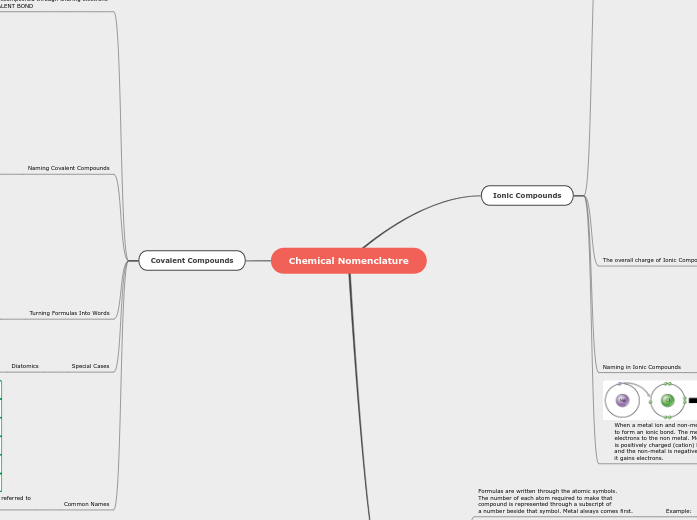Chemical Nomenclature
Ionic Compounds
Binary Ionic Compounds
A binary ionic compound is composed of ions of two different elements - one of which is a metal, and the other a nonmetal.
Ionic Compounds with
radicals (polyatomic)
2 or more atoms that are
contently bonded together and
have an overall charge
Formulas with Polyatomic Ions
You place brackets around the polyatomic
ion if there is more than one
This is important because it indicates in the
example above that
there are 2 hydroxide ions. Without it
would appear there are 2 hydrogen ions
** Brackets should only be used if there
is MORE THAN ONE polyatomic ion
only cation that is common for us
is ammonium (NH3)
This means instead of having a
metal as your cation in a ionic
compound you can have ammonium
because its positively charged.
Naming with Polyatomic Ions
1) Name the Metal
(unless NH3 is in the equation, then
that is named first because it is a cation)
2) Name the Polyatomic Cation
the ending does not need to be changed
(unless the equation is NH3 followed by
a non metal)
ex: Mg (OH)2
1) Magnesium
2) Magnesium Hydroxide
Fixed Valence Metals In Ionic
Compounds
Fixed valence metals in ionic
compounds are metals that
have one ionic charge
Lithium is a fixed Valence Metal
meaning its only ionic charge is
Li+1
MultiValent Metals In
Ionic Compounds
Metals that have
multiple ionic charges:
Some Examples:
When naming ionic compound formulas
with multivalent metals, you must indicate
which ionic charge it is with roman numerals
The overall charge of Ionic Compounds
Figuring out which ionic charge of
the multivalent metal for an equation
ex: FeO
In this ex we need to determine the charge of the Iron Ion
Since we know the overall charge of an Ionic Compound is zero we can create an equation to find the unknown value
by subbing in the charge of an Oxygen Ion (-2)
let X represent the unknown charge (iron)
Ionic Compounds have a net overall charge of ZERO
This means the total
positive charge + total
negative charge = 0
This can be put into
an equation:
Naming in Ionic Compounds
1) Name the metal (cation)
2) Name the non-metal (anion)
3) Change the ending of the
non-metal to "ide"
EX:
1) Aluminum
2) Aluminum Oxygen
3) Aluminum Oxide
When a metal ion and non-metal ion come together
to form an ionic bond. The metal will give its
electrons to the non metal. Meaning the metal
is positively charged (cation) because it loses electrons,
and the non-metal is negatively charged (anion), because
it gains electrons.
The attraction between
the positive and negative
charges create the ionic bond.
(called electrostatic attraction)
Formulas
Formulas are written through the atomic symbols.
The number of each atom required to make that
compound is represented through a subscript of
a number beside that symbol. Metal always comes first.
Example:
Crisscross Method
This is a method for creating
the formulas for ionic compounds.
Get the two ions you're dealing with, ex:
cross the charges. Although
the metal stays first in the
equation.
(if the charge is 1, it does
not need to be shown in the
formula)
Reducing in Ionic Compound Formulas
The formulas of ionic compounds
can be reduced.
If there is a common
between the amount of ions
you divide it by the GCF
(greatest common factor)
In this case the GCF is 2
Subscripts were divided by 2
Covalent Compounds
None metals combine through covalent bonds.
non-metals want to gain electrons because they
almost have a full valence shell. If two non metals want
to gain this can be accomplished through sharing electrons
this is called a COVALENT BOND
ex: water (H2O)
- both elements are non-metals (hydrogen and oxygen)
- both want to gain electrons not lose
Hydrogen only needs to gain one electron to fill its
valence shell
oxygen only needs 2 more electrons to fill its outer shell
They can both achieve full valence shells
by SHARING their electrons
this is allowed because the electrons being shared
belong to both of them at the same time
Naming Covalent Compounds
when naming covalent compounds you
use a prefix for each atom, this tells us the
number of atoms in the molecule.
the ending of the second atom is changed to "ide"
Prefixes
1) mono
2) di
3) tri
4) tetra
5) penta
6) hexa
7) hepta
8) octa
9) nona
10) deca
These are all placed before each atom to
indicate the number of atoms in the molecule
UNLESS the first atom in the equation
is only ONE you dont set the prefix as "mono"
you just leave it as it is. EX:
Turning Formulas Into Words
Just follow the prefixes
(no crisscross, no canceling)
Special Cases
Diatomics
These elements do not exist as single atoms.
they are gases which always appear as a pair
of atoms when they're naturally occurring.
therefore these are covalent compounds
as they consist of two non-metals.
When put into words these are
referred as (____ gas)
ex: Oxygen gas = O2
They are not named with prefixes
Common Names
These are covalent compounds that are frequently referred to
by common names rather than scientific ones.
